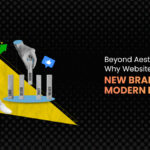Imagine walking into a store where the products are perfectly organized, the staff is attentive, and the checkout process is a breeze. Now use that experience on your e-commerce website. Customers make key purchasing decisions on your product pages, which serve as digital storefronts. To convert casual browsers into committed consumers, these sites must be optimized. Let’s look at actionable tactics for turning your product pages into conversion machines, using ideas from website design and development agency, Shopify web development services, and more.
1. Create a Strong First Impression.
The first few seconds a visitor spends on your product page can determine whether or not they complete their purchase. It’s similar to setting the stage for a spectacular performance; everything must be in place to catch and maintain attention.
a. Eye-Catching Images
Begin with high-quality, compelling images. Your product photographs should be sharp, well-lit, and show the goods from multiple angles.
Tip: Hire a UI UX design services provider to guarantee that your photographs are shown properly, including zoom-in tools and galleries for varied angles.
b. Interesting Product Titles
Your product title should be straightforward and detailed, with just enough information to capture the reader’s curiosity but not overwhelm them.
Tip: Use relevant keywords to improve search exposure and make sure your titles are easy to read and understand.
2. Create a strong product description.
A great product description is more than a list of characteristics; it’s a story that sells. Consider it a conversation with a possible buyer about their requirements and desires.
a. Emphasize key benefits.
Rather than focusing exclusively on the features, describe how they assist the customer. For example, if you’re selling a high-end blender, explain how its strong engine can produce smoothies in seconds, saving time in the kitchen.
Tip: Use storytelling to make your descriptions more relatable and interesting. Explain how the product will address an issue or improve the customer’s life.
b. Optimize for readability.
Use bullet points, brief paragraphs, and clear subheadings to divide text into manageable portions. This improves the user experience and ensures that important information is readily available.
Tip: Work with content writers who specialize in e-commerce to create interesting and SEO-friendly product descriptions.
3. Use High-Impact Product Media.
Visual and interactive content have a big impact on conversion rates. Consider these the digital equivalent of letting customers touch and feel the product.
a. Professional product photography.
High-resolution photos that capture the product in detail can have a major impact. Make sure your photographs are professional, as they represent the quality of your goods.
Tip: Work with a website design and development agency to achieve the finest visual presentation and make sure your images are optimized for fast loading.
b. Engaging Product Videos
Product films can show the product in action, highlight its distinctive qualities, and provide a more dynamic perspective. They can be especially useful for complex products that require a visual explanation.
Tip: Make short, instructive videos that are simple to grasp and convey the product’s value in a clear manner.
4. Streamline the mobile experience
With the increase of mobile purchasing, making sure your product pages are mobile-friendly is no longer an option, it’s a requirement.
a. Responsive design.
A responsive design adapts to various screen sizes, ensuring a consistent shopping experience across all platforms.
Tip: Use Shopify web development services to produce a mobile-optimized version of your product pages while maintaining functionality and aesthetics.
b. Mobile-specific enhancements
To improve the mobile purchasing experience, consider mobile-specific features such as larger touch target buttons, streamlined navigation, and faster load times.
Tip: Test your product pages on different mobile devices to guarantee they’re properly optimized and user-friendly.
5. Improve page load speed.
Slow-loading product pages can annoy users and cause cart abandonment. Speed is critical for sustaining engagement and increasing conversion rates.
a. Image optimization.
Compress photos to reduce file size while maintaining quality. This can significantly reduce page loading speeds.
Tip: Automate image optimization with tools or plugins, and consider lazy loading for images that aren’t immediately visible.
b. Minimize code and requests.
Reduce the number of HTTP queries and streamline the code to improve page performance. Combine CSS and JavaScript files whenever possible to save load times.
6. Use social proof.
Social proof, such as customer evaluations and ratings, can have a substantial impact on purchasing decisions by increasing trust and trustworthiness.
a. Visible Review Display
Display consumer feedback and ratings prominently on your product pages. Positive feedback can reassure potential customers and inspire them to make a purchase.
Tip: Include review and rating options on your product pages and make them easily accessible to visitors.
b. Respond to feedback constructively.
Respond to favorable and negative feedback professionally. Addressing complaints and expressing appreciation for feedback might help your brand’s reputation.
Tip: Use feedback to make informed decisions about your products and services.
7. Simplify the checkout process.
A quick, hassle-free checkout procedure is critical for avoiding cart abandonment and completing transactions successfully.
a. Reduce checkout steps.
Reduce the steps needed to execute a purchase. A simplified checkout process enhances the user experience and boosts the likelihood of conversion.
Tip: Provide a guest checkout option for users who do not wish to register an account, which will speed up the process.
b. Offer many payment options.
Support many payment methods to satisfy diverse consumer preferences. This can include credit cards, digital wallets, and other forms of payment.
Tip: Collaborate with agencies that provide digital marketing services to incorporate secure and convenient payment options into your checkout procedure.
8. Use effective calls to action (CTAs).
CTAs guide consumers to make a purchase. Make sure your CTAs are clear, enticing, and strategically placed to increase conversions.
a. Create urgency and scarcity.
Use terms like “Limited Time Offer” or “Only a Few Left” to create urgency and push customers to act immediately.
Experiment with various CTA designs and positions to see what generates the highest conversion rates.
b. Create eye-catching CTAs.
Make your CTAs stand out by using contrasting colors and placing them prominently on the page. They should be easy to locate and click.
Tip: Collaborate with UI UX design services to create visually appealing and effective CTAs.
9. Optimize for SEO.
SEO helps bring organic traffic to your product pages, increasing exposure and conversions.
a. Use relevant keywords.
Use relevant keywords in product titles, descriptions, and meta tags to boost search engine ranks.
Tip: Conduct keyword research to uncover terms that your target audience searches for, and then incorporate them naturally into your writing.
c. Improve the site navigation.
Ensure that your site’s structure adheres to SEO best practices. A well-organized website enables search engines to crawl and index your pages more efficiently.
Tip: Hire a website design and development agency to optimize your site structure and increase SEO performance.
10. Personalize the shopping experience.
Personalization improves the user experience and can increase conversions by responding to individual tastes and behaviors.
a. Implement product recommendations.
Use algorithms to recommend similar products based on a user’s browsing and purchasing behavior.
Tip: Use personalized recommendations to enhance average order value and encourage repeat purchases.
b. Display dynamic content.
Show dynamic material suited to the user’s interests, such as recently viewed products or special offers based on their browsing history.
Tip: Work with e-commerce website development firms to include dynamic content elements on your product pages.
Conclusion
Optimizing your product pages is critical for converting visitors into customers and increasing your e-commerce business. By emphasizing clear design, interesting content, mobile optimization, and continual research, you can create product pages that not only attract visitors but also generate conversions. Use the expertise of website design and development agency, Shopify web development services, and UI UX design services to properly implement these methods. With a result-oriented product page, you improve constantly and stay ahead.
Consider contacting digital marketing service and e-commerce website-building service providers to help you achieve your optimization goals.



